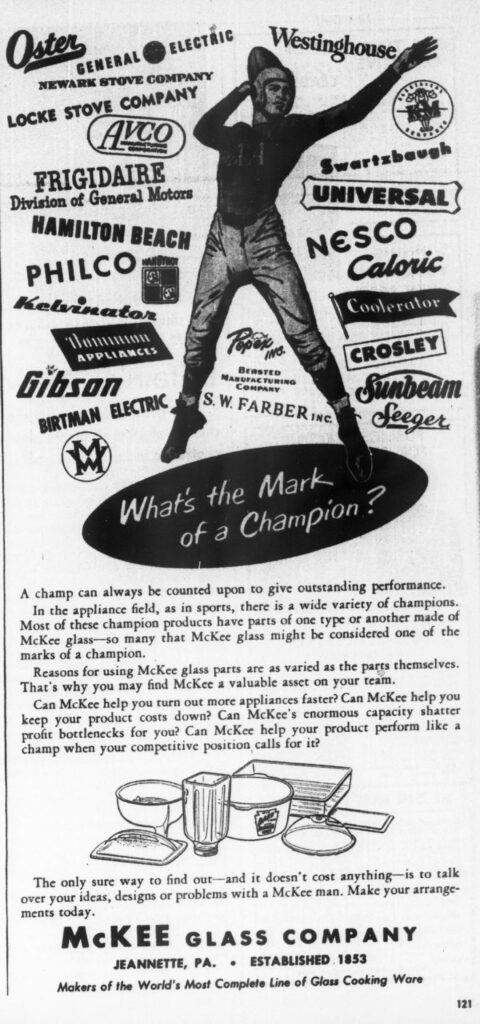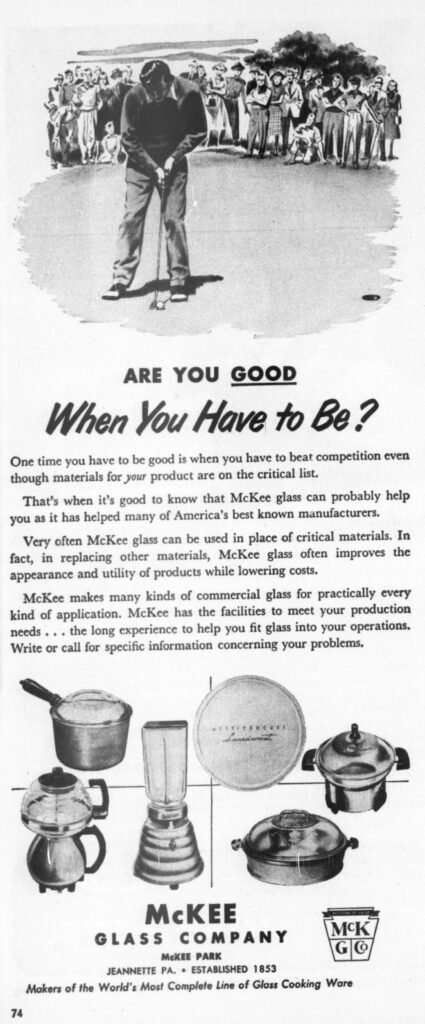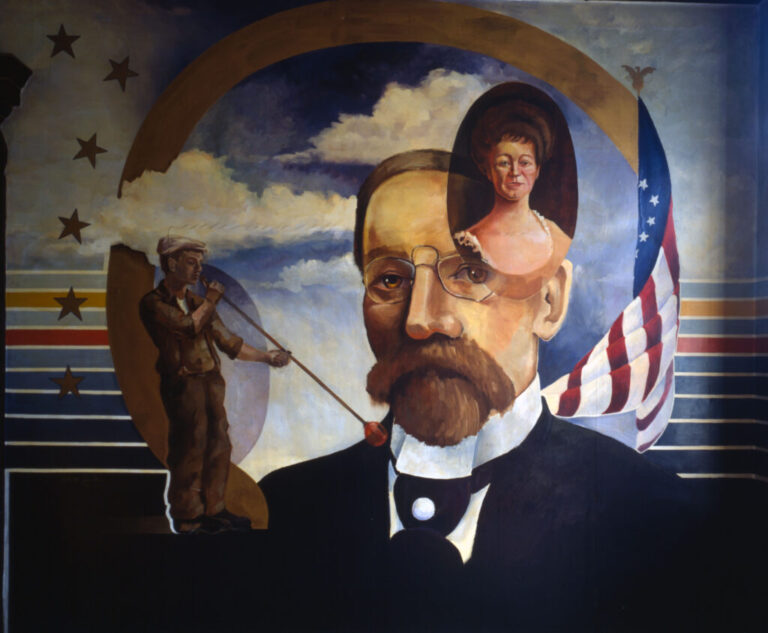
Collectors of tableware, kitchenware, and commercial glass highly value McKee Glass for its 125+ years of history, beauty, and durability. Although many of the company’s earlier creations do not feature identification marks, later products can be identified by labels such as Pres Cut, Glas(s)Bake, McK, and McKee. You can also find reproductions by Fenton, L.E. Smith and Wheaton/Kemple.
The history of the company in Jeannette has experienced several changes in leadership, starting with H. Sellers McKee and progressing through various members of the Smith family, alongside multiple acquisitions.
H. Sellers McKee played a key role in relocating the company to Jeannette after its run in Pittsburgh for 35 years and perhaps was influenced by the passing of his brother Stewart in 1885. Born in 1843, he was the son of Thomas McKee and the nephew of Samuel McKee, who was the founder of S. McKee & Co., a firm recognized for its production of window glass and bottles.
Sellers’ sons, Thomas (Tom) M. and Andrew Hartupee (Hart) McKee, also became involved in the family enterprise.
In 1887, McKee made the decision to relocate to Jeannette, Pennsylvania, in collaboration with the Chambers window glass company. This transition was driven by insufficient space for expansion in Pittsburgh, which had led to a disjointed manufacturing process. Financial factors also played a significant role in this choice.
After recovering from the economic downturn of the 1870s, Pittsburgh experienced increased city taxes and a significant reduction in available land. As manufacturers gradually moved from relying on river transport to utilizing railways, the demand for rail services grew, leading to congestion in the South Side of Pittsburgh.
Throughout the 1880s, notable glassmakers H. Sellers McKee and James Chambers faced challenges in expanding their businesses within Pittsburgh. They decided to establish a new town, Jeannette, PA, which allowed them to create fully integrated factories and forge a new partnership, culminating in the formation of the Chambers-McKee Window Glass Company.
By relocating to Jeannette, McKee and Chambers were able to construct larger manufacturing facilities and adopt advanced technologies that significantly improved production efficiency. One major advancement was the implementation of tank systems that functioned like conveyor belts for moving and processing raw materials, allowing glassworkers to operate continuously. This was a considerable enhancement compared to their previous method, which involved heating raw materials in pots within furnaces. The glassworkers had to wait on the pots, which created a step system and delays.
Some additional notes from the HABS’ (PDF) report:
- Chambers’ Pittsburgh plant had seven buildings over several noncontiguous acres and the new partnership, the Chambers-McKee Window Glass Company, at Jeannette had seventeen buildings on thirty-five abutting acres of land
- Similarly, McKee’s tableware factory at Jeannette was fifty percent larger than his Pittsburgh facility, covering four and one-half acres and, within five years, he more than doubled the factory’s capacity from sixty-five to one hundred forty-five pots
- They also used gas to fire the tanks and to flatten the glass, which meant better quality glass since they no longer had to contend with the sulfur residue produced by coal-fired furnaces
- To attract workers, Chamber and McKee built brick rowhouses in Jeannette, renting and selling them to workers at, we’re told, reasonable prices
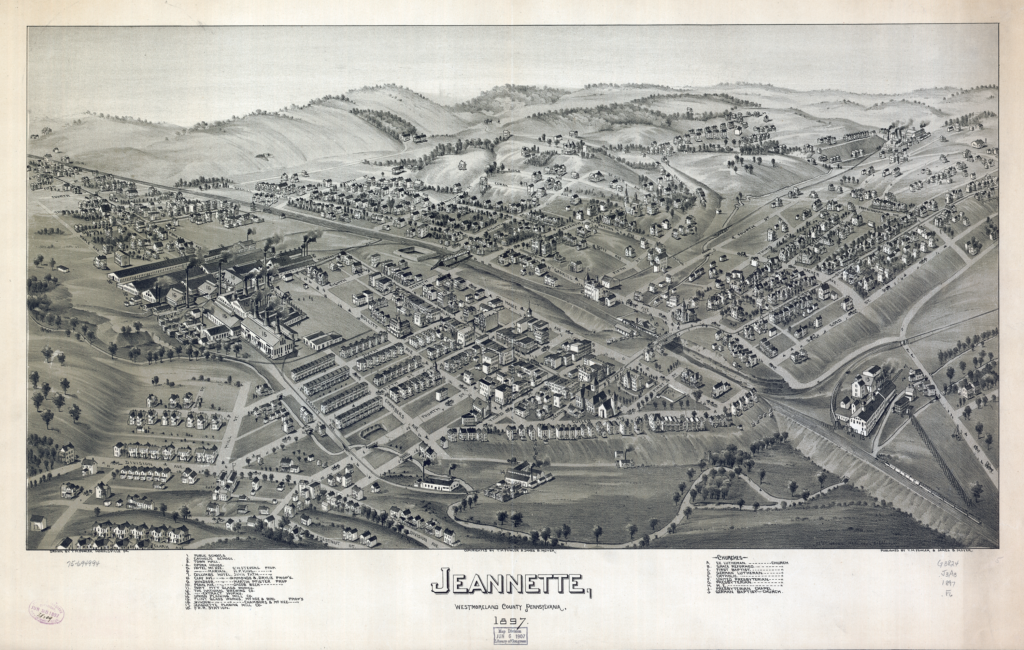
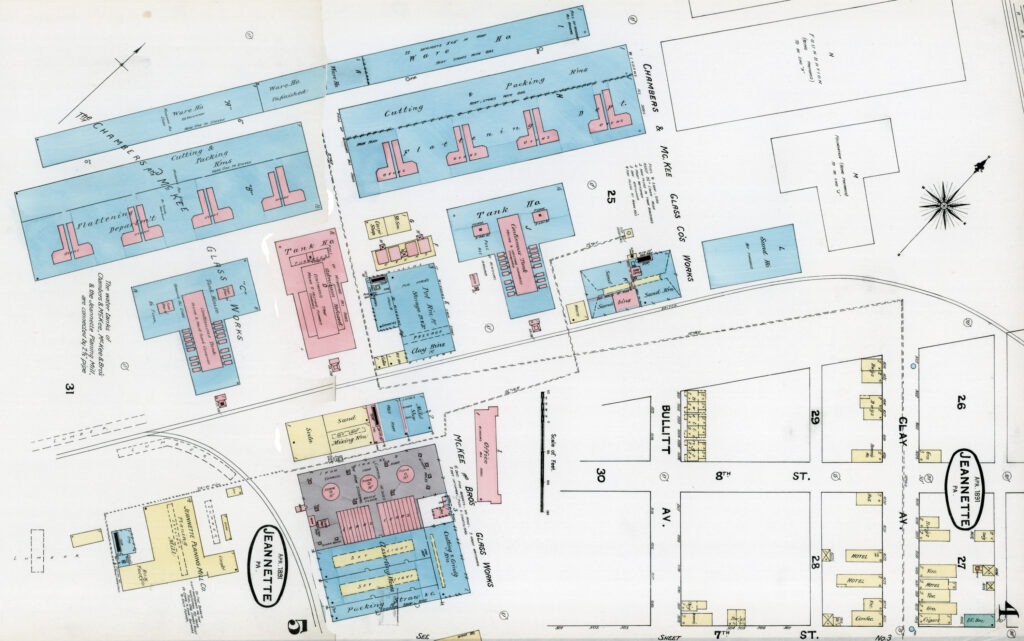
National Glass Works, McKee and the McKee-Jeannette Company
In 1899, the Mckee & Bros. became part of the National Glass Company with A. Hart McKee and H. Sellers McKee on the Board. This agreement did little for either company, with the National Glass Factory shares decreasing from $50 to $2 per share by 1904 when the company became a holding company. By 1907 it had declared bankruptcy. The McKee family had little involvement in the glassworks after this point.
- In 1904, the National Glass Factory leased the works to Andrew J. Smith, its manager, and it became known as the McKee-Jeannette Company
- The company focused its product line on higher grade glassware and tableware and eventually became known as the largest flint glass factory in America
- In 1908, following the National Glass Factory’s bankruptcy, Andrew Smith bought out the McKee Glass Co. and, that same year, the company launched its new Rock Crystal (Touraine) line, which is widely collected today
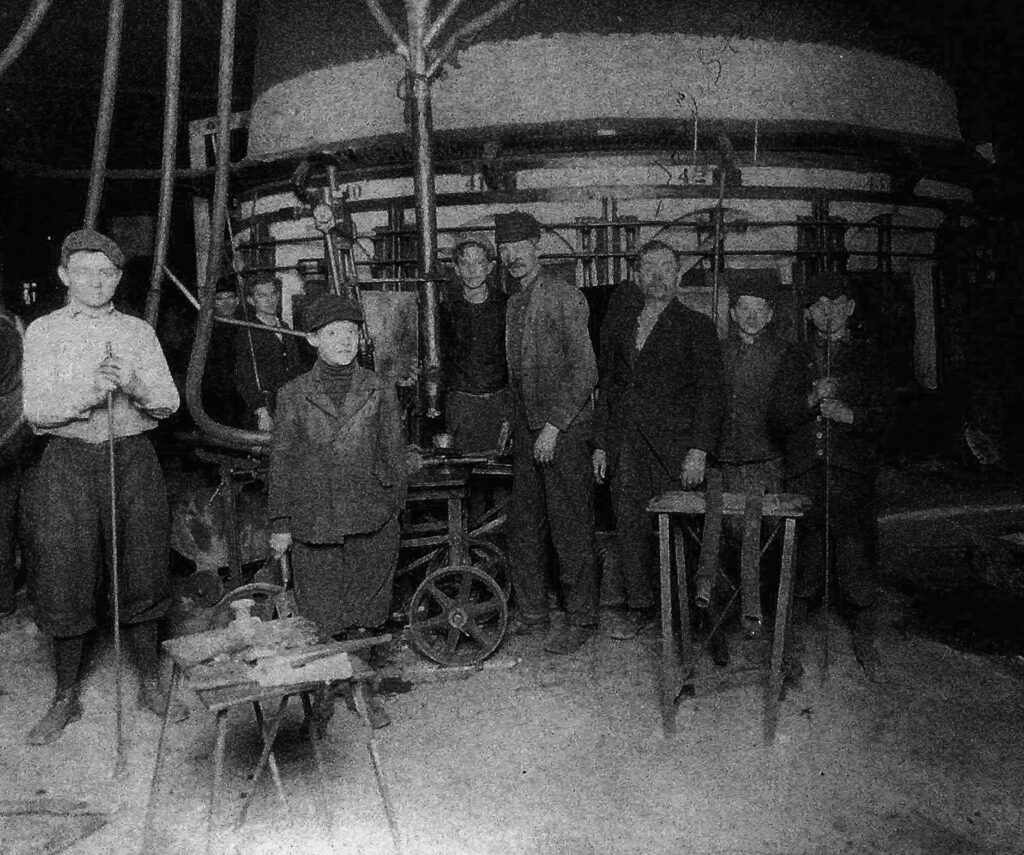
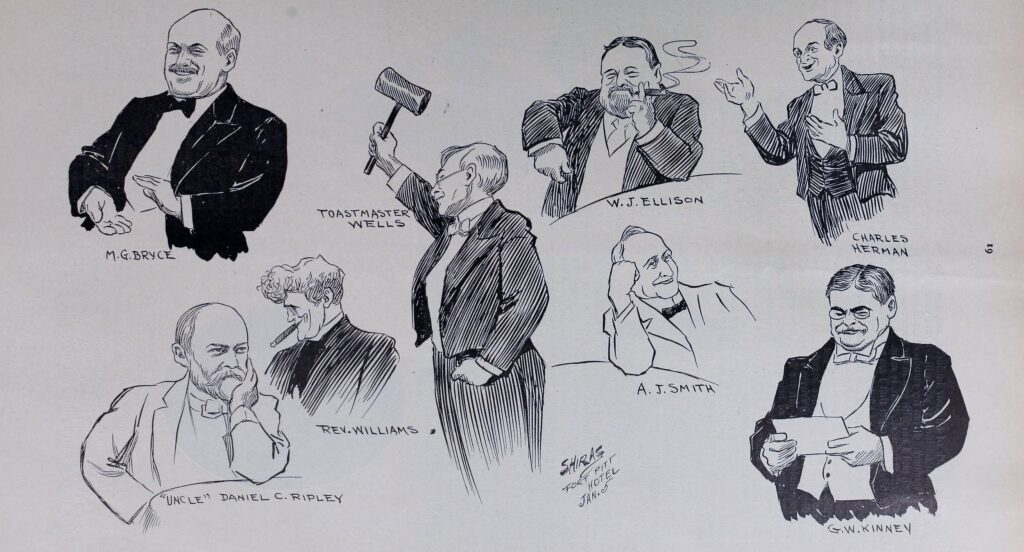
The Smiths, Thatcher, Jeannette, Coca-Cola and Bankruptcy
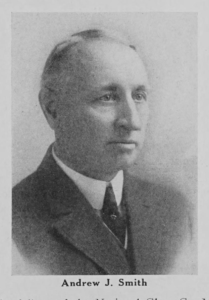
Andrew J. Smith, along with his sons Maurice and Donald, held the position of President at the company. In the early 1950s, the company was purchased by Thatcher, and later in the 1960s, it came under the ownership of Jeannette Glass Works. Subsequently, the Coca-Cola Bottling Company of New York acquired Jeannette Glass, which was eventually sold to private investors. A few years following this transaction, the company faced bankruptcy and liquidated its assets. Explore key events that took place from 1910 to 2017.
- In 1910, the McKee-Jeannette Glass Works was dissolved and the factory came under the control of A. J. Smith, who began to operate as the McKee Glass Co.
- The new company managed to obtain a license to manufacture pressed cut blanks from the Fry and Libbey even though both companies had or would end up suing McKee in the upcoming years
- In 1900s Hartman Furniture and Carpet Co. offers several of McKee’s patterns including Aztec
- In 1912, the The Atchison Daily Champion offers a set of Aztec Prescut water set or Fantec berry set with a six month subscription to the newspaper
- In 1912, Harry Barrett, 48 year old plant manager, is found dead by the railroad tracks
- In 1914, A. J. Smith becomes Chairman of the Pennsylvania Protective Union
- In 1916, the company introduces its Innovation line
- In 1917, the company starts to sell auto lenses to meet the new antiglare and dimming laws with the aim to reduce nighttime car-related fatalities
- In 1917, the company introduces Glasbake, a line of glass cookware
- In 1920, the Libbey wins their lawsuit against McKee
- Andrew J. Smith dies in 1924 and his son, Maurice Smith, becomes President
- In 1932, the company introduces the “Bottoms-Up” cup
- In 1933, the vacuum coffee maker is introduced
- In 1934, the company provides auto lenses for Ford’s 1935 line of cars
- In 1934, the company partners with Detroit Jewel company to include Glasbake with the sale of their gas ranges
- In 1935, the company introduces a line of refrigerator glass containers
- In 1936, the mixing bowls that were originally created for the Sunbeam Mix Master begin to be sold as a set of three
- In 1939, the company partners with OXYDOL who offers a baking dish for 20 cents with the purchase of their product
- In 1940, Kroger places a 3,000,000 Glasbake order as part of Kroger’s 58th birthday at a reported cost of $250,000
- Maurice Smith dies in 1940
- Maurice’s brother Donald assumed the presidency upon his brother’s death
- Donald Smith dies in 1941
- A. K. Wood named as President in 1941
- In 1942, the company launches a campaign encouraging people to use glass to “save vital metals for war production”
- In 1943, the company introduces its range top Range-Tec cooking line
- In 1948, McKee’s suit against Corning and Hartford-Empire is settled
- In 1949, four heirs of A. J. Smith, buy up the company’s stock and reorganizes
- In 1951, the company announces their merger with Thatcher
- In 1951, Coffee Hottles are introduced
- In Jan 1952, the former President of McKee, Arch K. Wood, was elected to Thatcher’s Board of Directors and W. A. Wood, who became the Vice President in charge of Thatcher’s McKee division
- In Aug 1961, Jeannette Glass Co. purchased the McKee Glass division from Thatcher Glass Manufacturing for an estimated $4 million in cash, stock and notes
- In 1961, McKee had an 18-acre site, 135K feet of manufacturing space, 175K feet of warehouse space 120K feet of offices space with a daily production capacity of 400 tons of glass
- In 1978, the Coca-Cola Bottling Plant of NY bought Jeannette from the long-time owner Maurice L. Stonehill for $39 million, which reflects the growth of the company which, in 1977, reported earnings of $3.4 million net against $59 million in sales and a headcount of 1,900 employees
- In 1981, the Coca-Cola Bottling Company of NY sold the Jeannette division to private investors, including Jeannette’s President since 1972, Mark Silverberg
- In 1983, Jeannette went bankrupt and its assets were sold to New York businessman Abraham Zion who purchased the factory for $4 million and promised to resurrect it, but it sat dormant for decades
- In 2017, following several years of disputes between the IDC, which acquired the property for $305,000 at a tax auction in 2012, and Zion, who passed away in 2016, efforts to clean up and redevelop the site commenced
- In 2019, IDC sells the 13-acre property to Elliott Group for $600,000, who supplies compressors and turbines for liquefied natural gas plants
